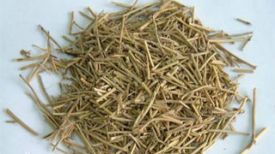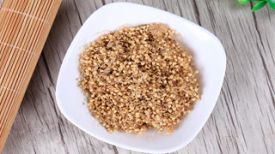
1. Aliases
Aristolochia cordata, green wood fragrant vine, Du Lin vine, Changsha vine, fragrant vine.2. Plant morphology
Perennial twining or creeping herbs. It has a fragrance. The root is cylindrical and the outer skin is yellow brown. The stem is twisted and has edges. Leaves alternate, triangular heart-shaped to broadly ovate heart-shaped, apex short acute or blunt, base heart-shaped, 5-7 basal veins, slightly grayish white below. Flowers 3-10, clustered in leaf axils; Pedicels slender and elongated; The perianth is purple, obliquely trumpet shaped, with a bulbous base; Stamens 6, attached to fleshy style; Ovary inferior, style 6, fused into a stigma, stigma short. The capsule is broadly ovate or elliptically obovate, drooping, and when ripe, it splits into 6 petals. The seeds are flat and have wings. The flowering period is from July to August, and the fruiting period is in September.
3. Origin distribution
Born on the roadside, in damp and shady places along ditches, and in the jungle on mountain slopes. Mainly produced in Zhejiang, Hubei, Jiangsu, Shaanxi, Jiangxi, and Henan.
4. Harvesting and processing
Harvest from July to September, remove impurities, and sun dry.
5. Characteristics of medicinal herbs
The stem is slender and cylindrical, slightly twisted, with a diameter of 1-3 millimeters; The surface is yellow green or light yellow brown, with longitudinal edges and nodes; Fragile, easily broken, with several vascular bundles of varying sizes on the cross-section. The leaves are mostly wrinkled, broken, dark green or light yellow brown, with obvious basal veins and slender petioles. The air is fragrant and the taste is light.
6. Nature, taste, and meridian tropism
Warm in nature and bitter in taste. Guigan Meridian, Spleen Meridian, and Kidney Meridian.
7. Effect and function
Promoting Qi and blood circulation, promoting diuresis and reducing swelling. Blood activating and pain relieving drugs belonging to the subcategory of blood activating and stasis removing drugs
8. Clinical applications
Dosage 4.5-9 grams, decoction in water; Apply an appropriate amount externally, boil and wash with water or mash and apply. Treat abdominal pain, joint pain, and pregnancy edema.
9. Pharmacological research
This product has a blood pressure lowering effect.
10. Chemical composition
Contains magnolia alkaloids, cyclocaryophylline, aristolochic acid, and β - sitosterol.
11. Taboos for use
This product contains aristolochic acid. Long term and excessive use can cause acute renal failure, chronic renal failure, tubular necrosis, urethral cancer, and other kidney diseases. It should be used with caution in clinical practice. Children and the elderly should use with caution; Prohibited for pregnant women, infants, and those with renal insufficiency.
12. Compatibility prescription
① To treat hernia and pain: 30g of Tianxian Vine, a bowl of good wine, boil until half a bowl is served. (Sun Tianren's Collection of Effective Prescriptions)
② Treatment of rheumatoid arthritis: 9 grams each of Tianxiandong, Weilingxian, and Haitong bark. Boiled in water. (Natural Medicinal Records of Qinling and Bashan Mountains)
③ Treat venomous snake bites, hemorrhoid swelling and pain: Mash fresh Tianxiantang and apply to the affected area. (Handbook of Commonly Used Traditional Chinese Medicine in Northeast China)
④ Treatment of mastitis: Take an appropriate amount of fresh Tianxian Teng, knead and apply externally, and change the dressing once a day. (Jiangxi Herbal Medicine)
⑤ Treatment of Red Flowing Pill Swelling: 30g of Celestial Vine, roasted as powder, 3g of frankincense (ground). Every 3 grams above, warm wine below. (According to the Guidelines for Diagnosis and Treatment, frankincense powder)
The content of the article is for clinical reference only. Non professionals in traditional Chinese medicine are not allowed to try medication.


